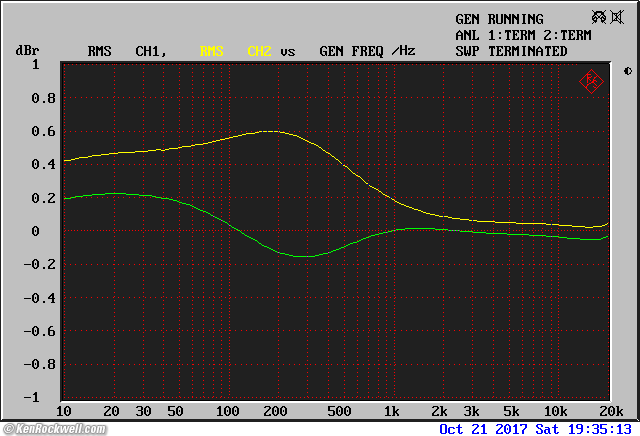Home Donate New Search Gallery Reviews How-To Books Links Workshops About Contact
Crown Straight Line Two
SL-2 and PSL-2 Stereo Preamplifiers
Made in USA (1981-1995)
Crown Straight Line Two SL-2 Preamplifier. bigger.
Rear, Crown Straight Line Two SL-2 Preamplifier. bigger.
I got my Straight Line Two for about $500 at this link directly to them at eBay. See How to Win at eBay.
This all-content, junk-free website's biggest source of support is when you use those or any of these links to approved sources when you get anything, regardless of the country in which you live. Buy only from the approved sources I use myself for the best prices, service, return policies and selection. Thanks for helping me help you! Ken.
August 2018 Crown reviews audio reviews all reviews
The Crown SL-2 packs exceptional audio performance and a lot of features into just one rack space. Add this to excellent design and construction quality and you'll see why they routinely sell for $500 today - even though they are 35 years old. Crown made these superb preamplifiers in Elkhart, Indiana, USA from 1981~1995.
The SL2 has two tape loops, a fixed external processor loop (EPL), a precision phono preamp with calibrated gain, 1% resistors and 2.5% capacitors, tone controls, a stereo-mono-reverse-mute control, a rumble filter and indicator, and all these can be bypassed one-by-one, giving rise to the STRAIGHT LINE TWO model name. There's also a superb switchable Loudness contour that's the best I've heard, boosting the extreme deep bass and not muddying up the midbass.
The earlier Straight Line One was a very primitive preamplifier that took up two rack spaces and wasn't much more than a selector and volume control.
This STRAIGHT LINE TWO lives up to it's name, with actual measured performance of both the ancient samples I've tested of 0.00005% THD (that's four zeros!) and +0, -0.4dB response from 4 Hz ~ 110 kHz!
The SL-2, seen here, was made from 1981~1985 and the PSL-2 was made from 1987~1995. The PSL-2 is the same, except that the AUX 1 input is labeled "C.D." and AUX 2 is simply called "AUX."
The SL-2 came in silver as seen here, as well as with a black face with the same silver aluminum knobs. Early models used the shiny turned aluminum knobs with deeply engraved index lines as seen here. Later models used matte aluminium knobs with just tiny engraved index arrows on the front of each knob. The PSL-2 only came with the black face and matte silver aluminum knobs with the small engraved arrows. The knobs are extremely solid, and believe it or not, are push-on knobs with very solid metal outsides and plastic innards.
While all are rack mountable, some have handles on the sides as shown here, and some don't. The handles are most common on the earlier SL-2 and less common on the newest PSL-2, but they come both ways and the handles come in either color.
Like all Crown products, these preamplifiers are very durable. The first sample I bought arrived flopping around in a box shipped 3,000 miles with no packing material or padding and mostly worked, except for some of the front panel LEDs. No worries, even though the seller made no efforts to correct this, eBay's Money-Back Guarantee gave me a full refund so I got rid of it and bought another. Service information and most of the parts are readily available and most of these should run forever. It runs on common TL082, TL084 and NE5532 op amps on ±18V supplies for greater than 10 V RMS output.
There are two tape loops, but no front-panel EPL switch so you must use jumpers as shown above to connect the PROCESSOR LOOP output to its input — or you won't get any output!
Frequency Response
Measured from the AUX 1 input driven from the 5Ω source impedance of the R&S UPL at 1 V to the MAIN 1 output, terminated by the 200kΩ load of the UPL. The SL-2 is set to level 28 (unity gain).
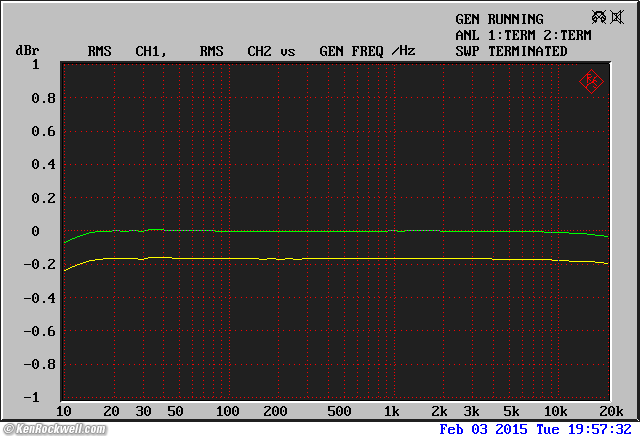
Frequency response, AUX 1 in to MAIN 1 out.
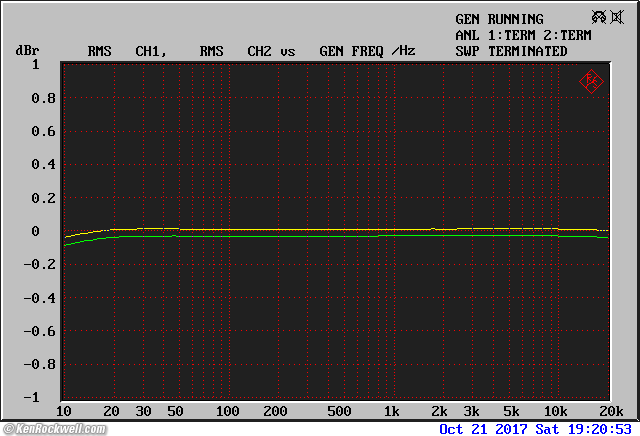
Frequency response, second sample, 22 µF output coupling capacitors bypassed.
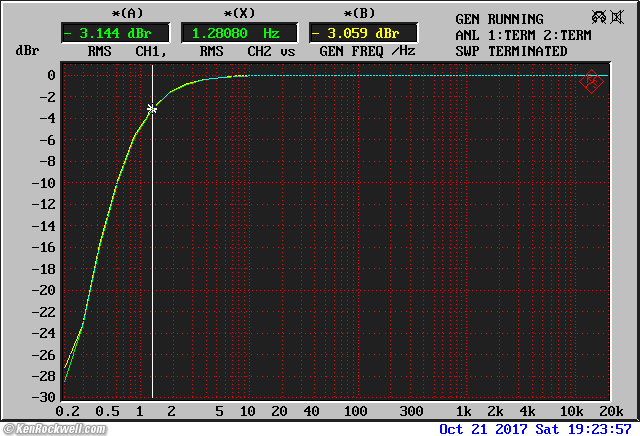
Infrasonic frequency response, second sample, 22 µF output coupling capacitors bypassed.
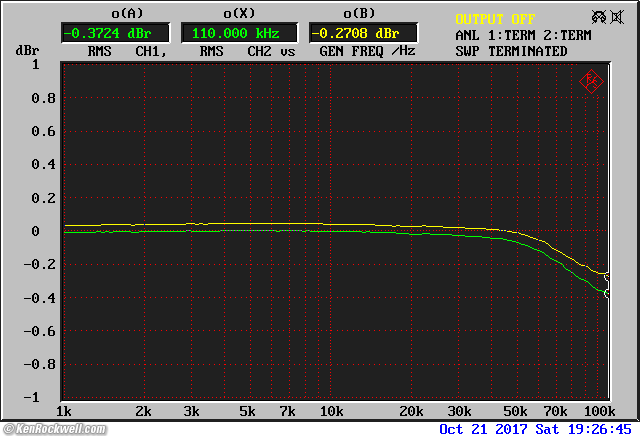
Ultrasonic frequency response, second sample. 22 µF output coupling capacitors were bypassed and 560Ω build-out resistors bypassed with 91Ω resistors, making the effective output source impedance about 86Ω.
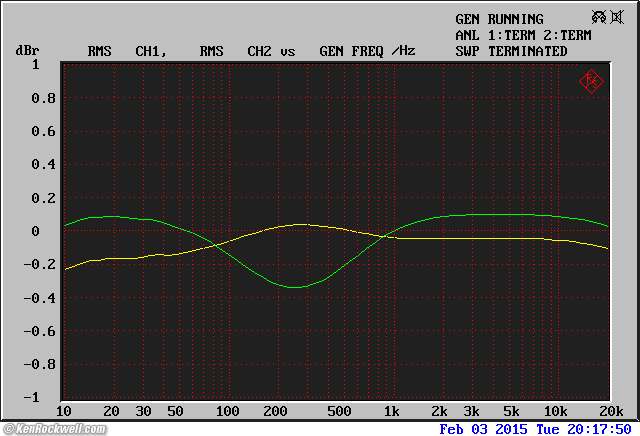
AUX 1 in to MAIN 1 out, Tone at zero.
Tone at zero, second sample.
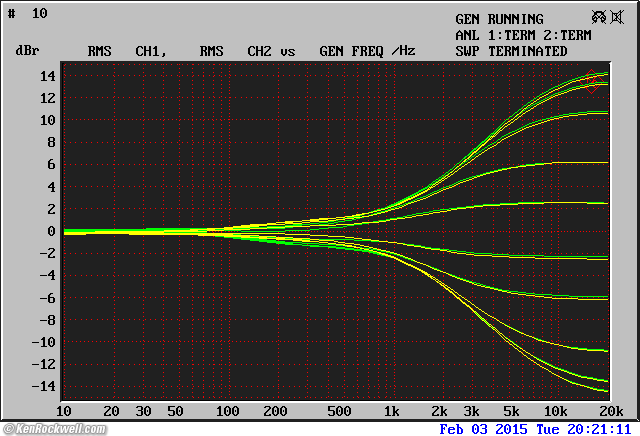
Treble -5, -4, -3, -2, -1, +1, +2, +3, +4, +5.
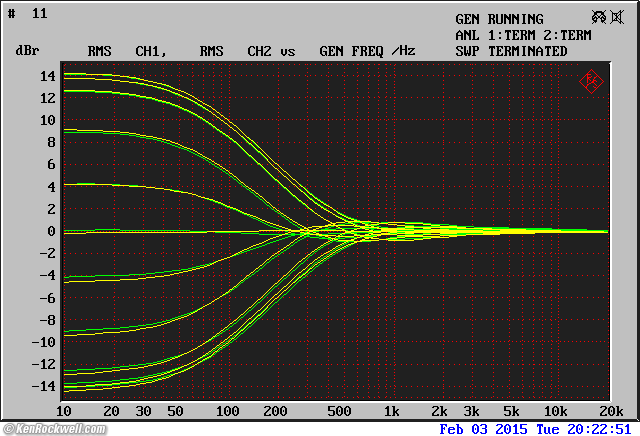
Bass -5, -4, -3, -2, -1, 0, +1, +2, +3, +4, +5.
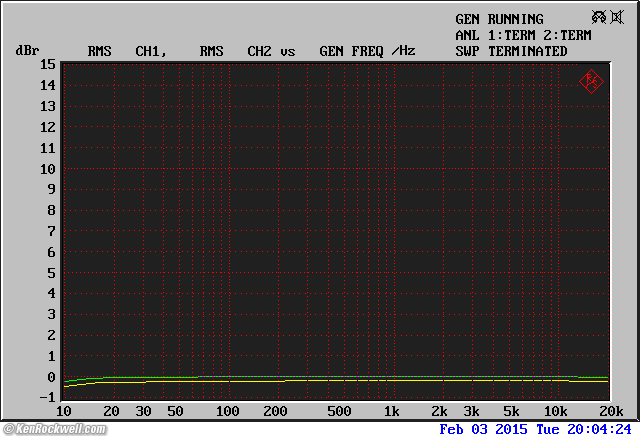
Loudness 0
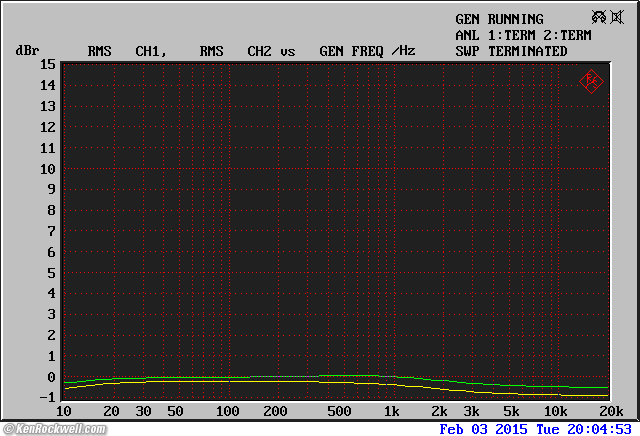
Loudness 10
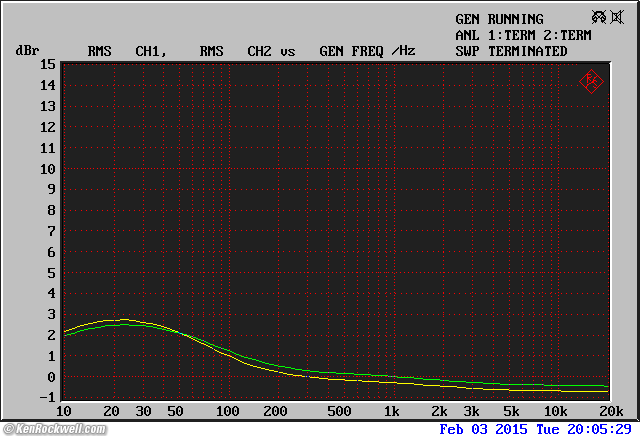
Loudness 20
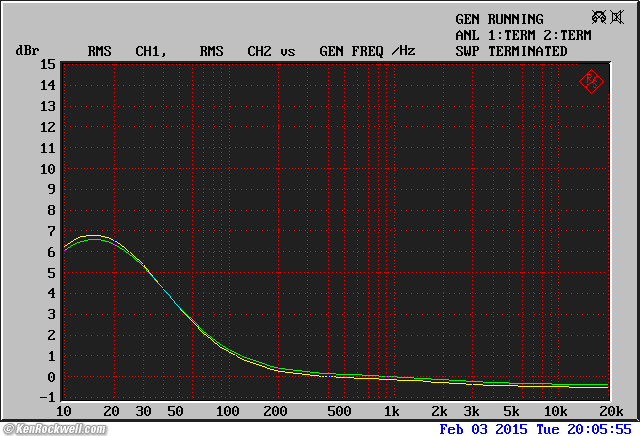
Loudness 30
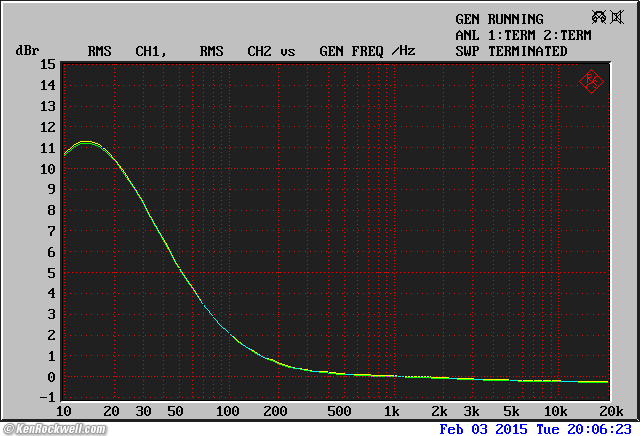
Loudness 40
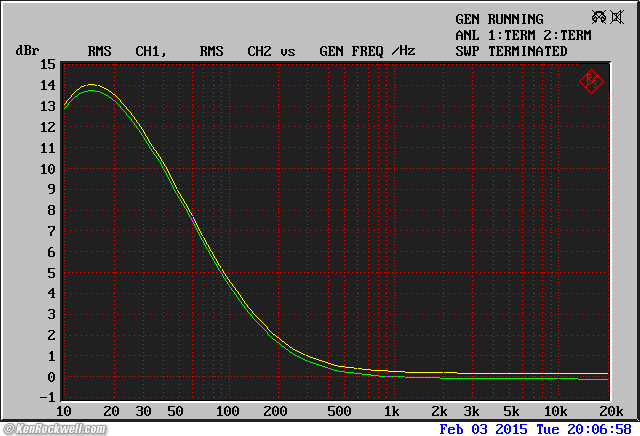
Loudness 50
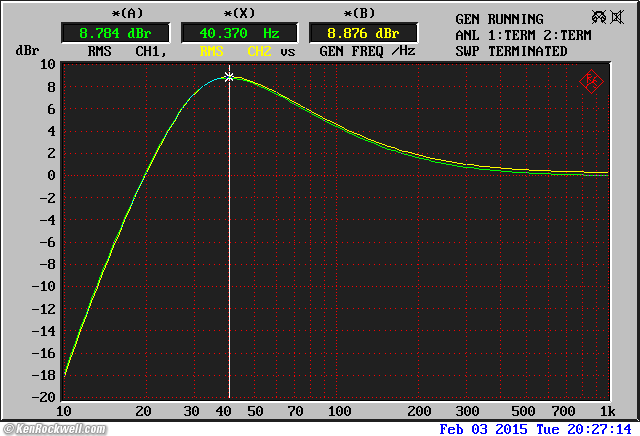
Loudness 50 + Filter
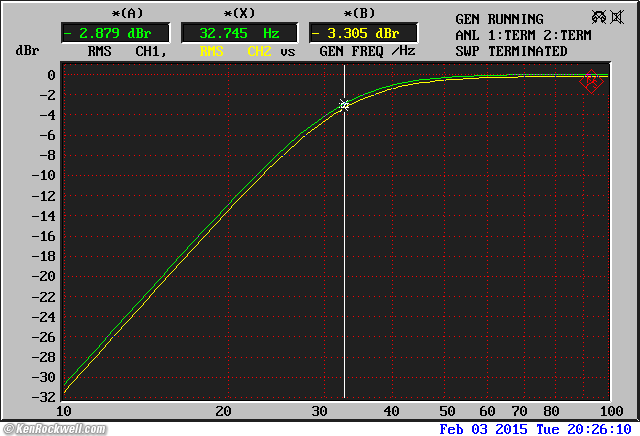
Filter response, first sample.
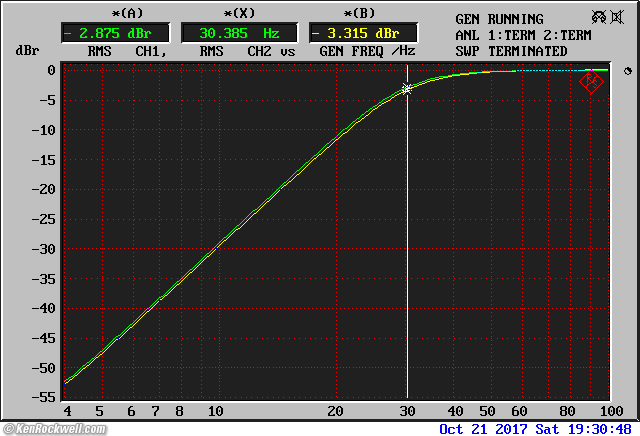
Filter response, second sample, 22 µF output capacitors bypassed.
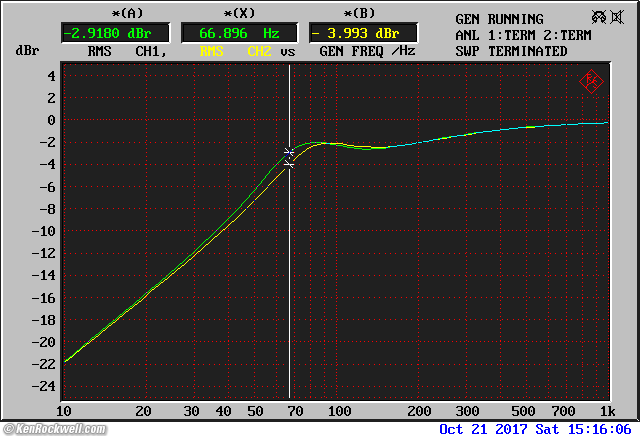
AUX 1 in to MAIN 1 out — but with Grado SR80e 32Ω headphones plugged into the Monitor jack. The 22 uF output coupling capacitors were loaded by these headphones, along with the 22Ω series build-out resisters, to attenuate the low frequencies. Shorting across these capacitors restores straight-line performance — or use 600Ω headphones.
Distortion
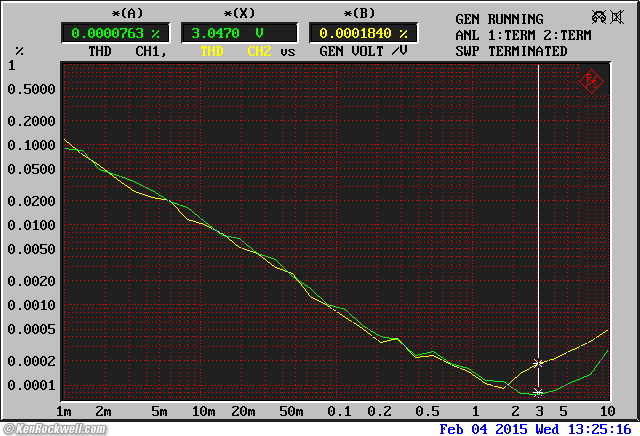
THD at 1 kHz.
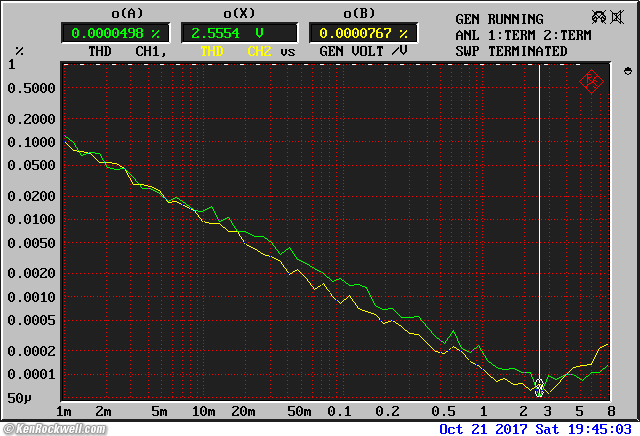
THD at 1 kHz, second sample.
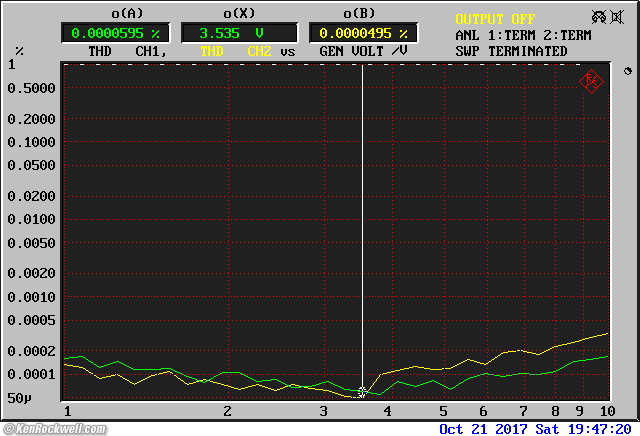
THD from 1V to 10V output at 1 kHz, second sample.
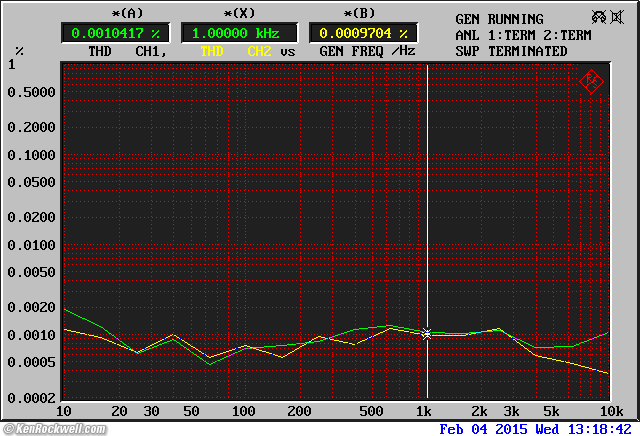
THD at 100 mV
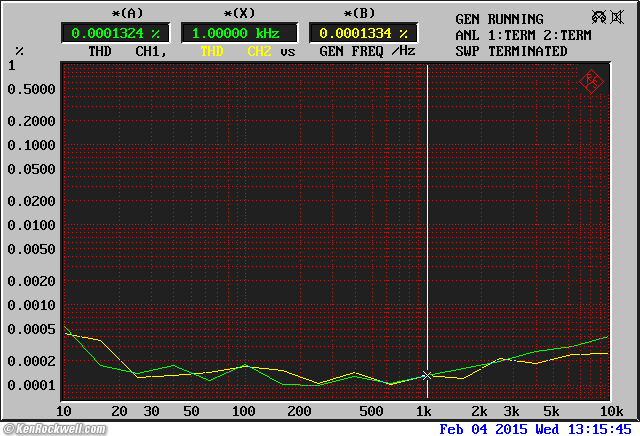
THD at 1V
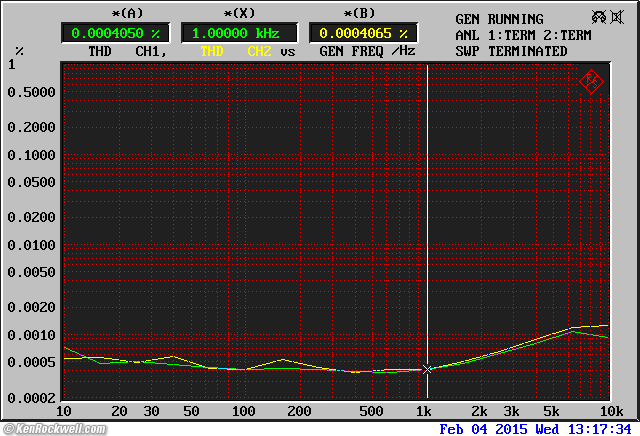
THD at 10V
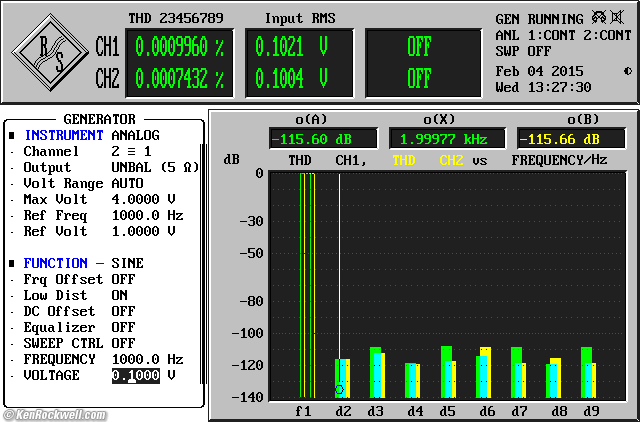
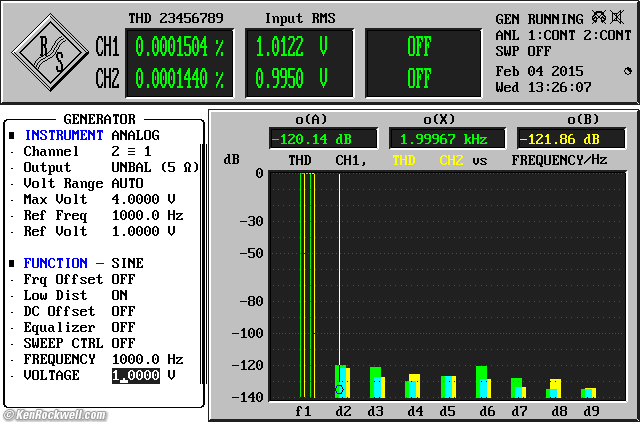
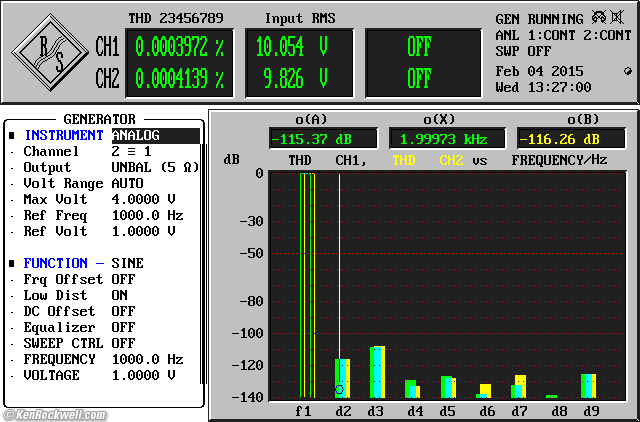
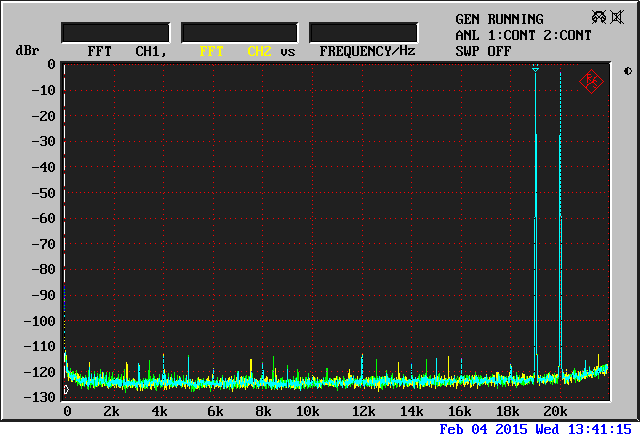
DFD 1V
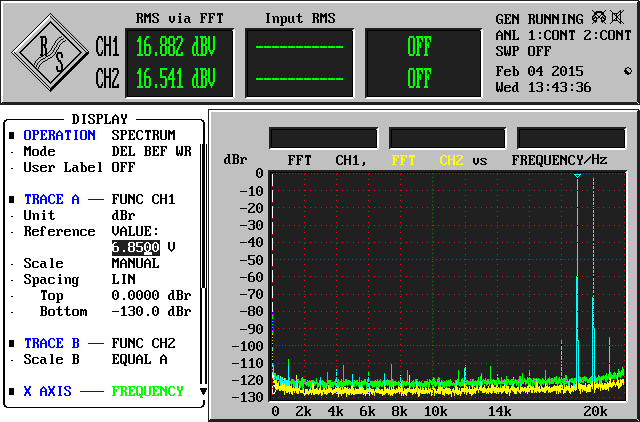
DFD 6.85V
![]()
Channel tracking. + (up) Image moves left, - (down): image moves to right.
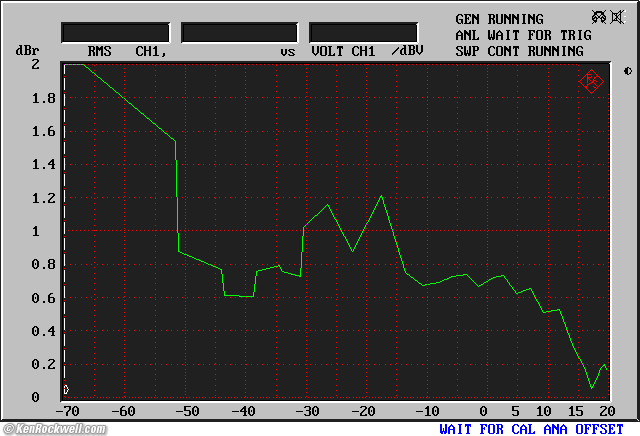
Channel tracking, second sample. + (up) Image moves left, - (down): image moves to right.
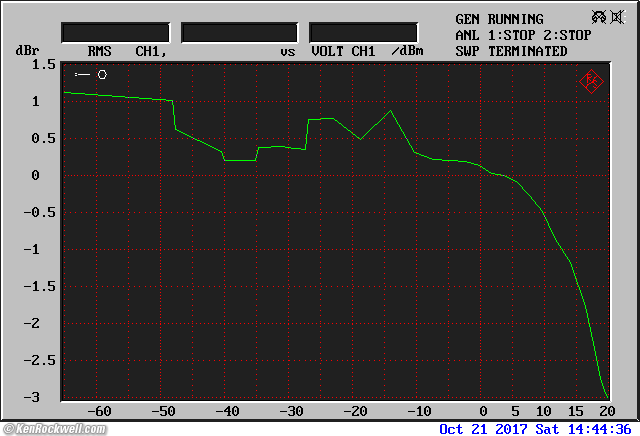
Channel tracking, second sample, after I calibrated it for ±0 at 0 dB gain at level 28. While the image is 3dB to the left at full gain where no one ever listens, I restored the balance to ±0.8 dB from -48 dB to +12 dB gain where we actually use a preamp.
Phono Section
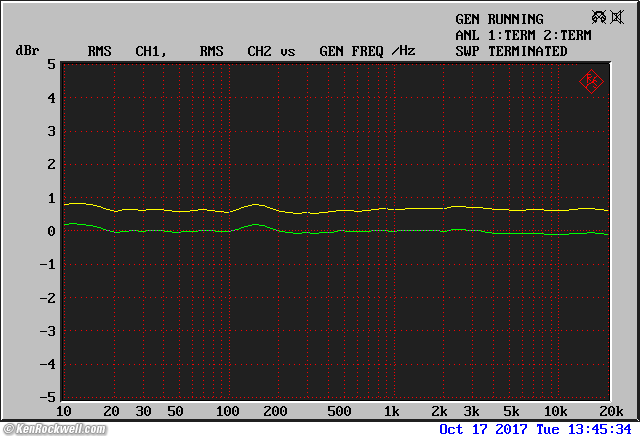
Phono to Tape 1 Out response, deviation from RIAA.
It uses very high precision components in the phono preamp for much more accurate RIAA phono response than other consumer phono preamps. It's flat to ±0.2 dB from 7 Hz to well over 20 kHz!
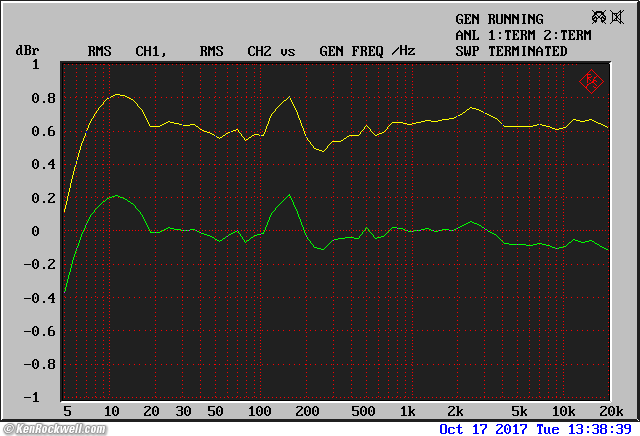
Phono to Tape 1 Out response, deviation from RIAA.
CROWN STRAIGHT LINE TWO
Cover of Audio Oct 1982
Shorten turn-on delay, now 8.2s
Modify bass control
Scratchy right treble control
Left side balance dirty
Dirty tape one monitor
Phono hum
11 pounds (5 kg)
11-1/2" deep
1/8 A fuse
Well balanced channels, full featured and quiet.
$479 1981 = $1,250
$479 1982
$549 1984 = $1,250
Oct 1985: $595 (DL-2 was $2,999)
$595 PSL2 1987
$695 1990 PSL2
$795 1991, 1992, 1993, 1994 PSL2
1995 $995 PSL2
1996 no listing
Headphone output has no turn on delay
Easy-glide, well tracking level control
Heater power cord, heavy duty switched outlets
14.2 watts at 116v cold
10.9 at 117 warm idle
12w ovld lit
7 second delay rated
8.6 actual
18 v supplies
16 v regulated from 18v for phono section
Power LED direct from +18v line
Tape outs hard wired; not buffered
EPL fed from hard wired input selector
Detectors at three stages peak hold overload protection indicator. Detects phono overload even if only sent to tape out for instance.
TL072 TL074 and NE5532
Line out fed via 560 ohm series resistor
Headphones fed via 22 ohm series resistor from same NE5532 output amp
2.5% capacitors phono stage
Gain: vary either up or down rotation direction to get to stop, then measured counterclockwise
Flat
20.056/19.894 0
20.006/19.795
19.721/19.486
19.420/19.112
18.821/18.399
18.048/17.641 10
16.966/16.612
15.325/15.035
13.605/13.281
11.124/10.635
8.481/8.181 20
6.252/5.969
4.229/3.942
2.1375/1.8821
0.2578/0.1243 28
-1.7722/1.9028 30
-3.978/4.086
-6.122/6.117
-8.365/8.399
-11.006/11.022
-14.109/14.043 40
-18.379/18.307
-22.072/22.201
-26.542/26.799
-30.781/30.604
-34.63/34.38 50
-40.76/40.50
-46.78/46.81
-56.17/58.27
-86.4/79.2
-89.8/84.5 infinity (60)
-103/101 mute
-125 tuner input
Loudness on:
20.065/19.864 dB 0
20.026/19.881
19.901/19.799
19.740/19.551
19.321/18.985
18.529/18.125 10
17.452/17.070
15.922/15.608
13.894/13.514
11.594/11.106
8.936/8.644. 20
6.779/6.443
4.476/4.167
2.4049/2.1350
Step 28 (one above 30) is 0.4535/.2566 dB
-1.5992/-1.7199
-3.495/3.530
-5.610/5.573
-7.913/7.883
-10.739/10.764
-14.096/14.080 40
-18.151/18.070
-21.792/21.897
-30.583/30.441
-34.60/34.36 50
-40.62/40.35
-46.52/46.55
-55.69/57.95
-80.1/79.5
-84.2/82.7
-94.05/103.89 mute
-132 other input selected
Wide range and well tracked
Loudness good compensation with dt880
Loudness good at really soft levels, not good for general use
Mono shorts to perfect balance, balance control ignored except as input mixer
Reverse reverses balance control, too.
Tone delta gain: -0.0461/+0.0708 dB
Noise -104.8 dBV A -102 dB 22k
same at zero gain
-110 dBV at MUTE
-95 dBV at max gain
OVLD at 10.45v at 0.005% with tone active
10.466 at 0.0005% no tone
Detects 1mS easily and holds
11.5V at 0.1%. MOL
SPI starts at 100mV, on at 1V
THD Same with 1V in for 100mV out or 100mV in for 100mV out
Phono
40.27/40.30 dB
OVLD 98mv in 10.1v out 0.0005 THD
107.3 mv in 11.01 out 0.1pct
-90/80 dBV A, -86.7/71.0 unweighted
Low cut Filter is harsh, but perfect for vocal classical.
Feed Stax from main 2
Put Expander in EPL, program or headphone EQ in tape 1 and 2.
Can't concatenate tape as two EPLs because tape output is shorted when one sets copy mode that would be needed.
Toggle switches would have been better. Push buttons too much work, too slow and can't see their positions - but they feel nice.
Semi-generic bass control. Not useful. Better than most, but not as good as Apt or Adcom.
Great treble control, perfect for correcting things that are too brilliant.
SECOND SL-1 17 Oct 2017 010741 different dull knobs lacking indices
4.4W consumption w/1V outputs (70mA)
6.4s turn on delay
Gain: 19.875/19.701 dB (w/tone: 19.713/19.709 db)
at 30: -1.48/-2.145 dB
SPI first on at -30 dBV, fully on at +4 dBV (half wave detection)
OVLD at 10.3 V at 0.007% THD; 0.1% at 11.6V
Phono overload 105mV 1kHz, 11 mV 20 Hz, 990 mV 20 kHz. Phono gain via tape:
Rumble filter: -3.0 dB at 30.0 Hz
Noise: (a couple dB higher on lower channel if balance control is set midrange either way)
0: -98.8 dBV A, -95.6 dBV
10: -99.5 dBV A, -96.4 dBV
20: -102.2 dBV A, -99.0 dBV
30 Unity gain: -105.2 dBV A; -102.2 dBV
40: -105.6 dBV A, -102.5 dBV
50: -105.8 dBV A, -102.7 dBV
Inf: -105.8 dBV A, -102.7 dBV
(unchanged with tone controls)
WORK 21 OCT 2017 about 5 PM:
Balanced gain for 0.00 dB at level 28.
Shorted across 22uF/50V output capacitors C139 & C239 to improve headphone LF response with 32Ω phones.
Shunted across R152 & R252 (560Ω each) with 91Ω 1/2W 5%, now measure 89Ω across each to lower output impedance to combat hum pickup. 2.2dB drop with 300 ohm load = about 88 ohms output impedance.
Replaced C20 with 0.22uF ±20% 75V (measures 0.2uF). C20 was 0.47uF, not 0.2 per schematic. Delay is now 2.8s, down from 6.5s.
Now gain is:
17.015/20.407 00 bal -4
17.011/20.389
16.870/20.147
16.570/19.756
16.184/19.217
15.643/18.541 10 bal -4
14.994/17.738
13.968/16.249
12.531/14.355
10.425/11.626
7.986/8.871 20 bal -2
5.894/6.389
3.888/4.171 24 bal -3.5
1.8822/1.9985 26 bal -2
0.0012/0.0453 28 (-0.0255/+0.0043 coming up)
-2.0795/-2.0943 30 bal 0
-5.156/-4.257 32 bal 0
-6.422/-6.554 34 bal 0
-8.749/-8.920 36 bal 0
-11.684/-11.901 38 bal 0
-14.326/-14.583 40 bal 0 or +1
-18.488/-19.334 42 bal +2
-22.691/-23.152 44 bal +1
-27.011/-27.903 46 bal +2
-31.353/-31.69 48 bal +1
-34.97/-35.35 50 bal +2
-38.97/-39.19 52 bal +2
-44.52/-44.84 54 bal +2
-51.80/-52.86 56 bal +2.5
-73.5/-78.6 58 bal +4.5
-114.5/-98.6 inf. bal -7
Rumble light on at (full wave detection):
11.5V 1k, 500, 250, 125, 62.5
3V at 30 Hz
1.5V 20 Hz
1.1V 16 Hz
0.8V 12.5 Hz
0.6V 10 Hz
0.5V 8 Hz
0.35V 6.3 Hz
0.3V 5 Hz
0.35V 4Hz
0.18V 3.2 Hz
0.15V 2.5 Hz
100 mV 2 Hz
40 mV 1 Hz
15 mV 0.5 Hz
© Ken Rockwell. All rights reserved. Tous droits réservés. Alle Rechte vorbehalten.
Help Me Help You
I support my growing family through this website, as crazy as it might seem.
The biggest help is when you use any of these links when you get anything. It costs you nothing, and is this site's, and thus my family's, biggest source of support. These places always have the best prices and service, which is why I've used them since before this website existed. I recommend them all personally.
If you find this page as helpful as a book you might have had to buy or a workshop you may have had to take, feel free to help me continue helping everyone.
If you've gotten your gear through one of my links or helped otherwise, you're family. It's great people like you who allow me to keep adding to this site full-time. Thanks!
If you haven't helped yet, please do, and consider helping me with a gift of $5.00.
As this page is copyrighted and formally registered, it is unlawful to make copies, especially in the form of printouts for personal use. If you wish to make a printout for personal use, you are granted one-time permission only if you PayPal me $5.00 per printout or part thereof. Thank you!
Thanks for reading!
Mr. & Mrs. Ken Rockwell, Ryan and Katie.


